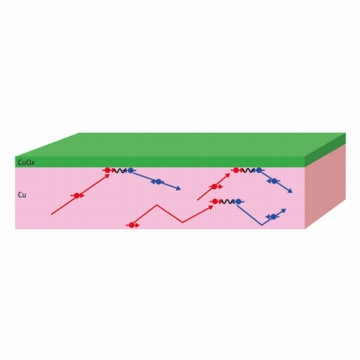Home > Press > Cold copper stops the spin
 |
| Figure 1: Electron scatterings inside copper (Cu) sometimes flip the spin directions. On the other hand, scatterings at the boundary between Cu and copper oxide (CuOx) flip the spin every time.
Copyright © 2008 Takashi Kimura |
Abstract:
The performance of spintronic devices depends on several temperature-dependent scattering mechanisms
Cold copper stops the spin
Japan | Posted on June 20th, 2008In the future, many electronic systems could be replaced by spintronic devices, which communicate information via the intrinsic angular momentum, or spin, of electrons. Now researchers at the RIKEN Advanced Science Institute (formerly the Frontier Research System) in Wako and the University of Tokyo have completed an important study into the effects that temperature can have on spintronic devices1.
Spintronics relies on the effective transport of ‘spin-polarized' currents, in which electrons all have the same spin. Spin-polarized currents flow well in magnetic materials, but when they enter non-magnetic materials the electrons begin to lose their spin polarization in a process called spin-flip scattering (Fig. 1). The length scale over which the electrons remain polarized, called the spin diffusion length, is particularly important for fabricating devices.
Spin-flip scattering is known to occur in two different ways. At high temperatures, most of the scattering is caused by electrons interacting with ‘waves of heat' called phonons. Otherwise scattering is caused by impurities, defects and boundaries in the material.
To investigate the effects of temperature on spin-flip scattering, the researchers fabricated a ‘lateral spin valve' consisting of two magnetic electrodes that inject a spin-polarized current through a copper wire. The distance between electrodes was altered in order to observe the spin diffusion length of the copper at different temperatures.
The researchers found that the spin diffusion length of the copper increased as temperature was decreased. This was expected, because the phonon scattering decreases with temperature. However, there was an unexpected maximum at around 30 K (-243.15 °C), below which the spin diffusion length decreased again.
The researchers explained this effect by considering the wire surfaces, which are oxidized by the surrounding air and cause strong spin-flip scattering. At very low temperatures, the polarized electrons travel further on average, so they are more likely to collide with the wire surfaces. This explanation was verified by tests with different thicknesses of wire, showing that thinner wires with greater surface-area-to-volume ratio experience a greater level of scattering at low temperatures.
In very small devices, the scattering by oxidized copper surfaces could cause problems for real, room-temperature applications. RIKEN team-member Takashi Kimura suggests making use of aluminum, which reflects electrons rather than scattering them.
"We did not observe the spin signal maximum at low temperature in an aluminum lateral spin valve," he explains. "Therefore, if we use an aluminum capping layer on top of the copper wire, it may prevent the present problem."
Reference
1. Kimura, T., Sato, T. & Otani, Y. Temperature evolution of spin relaxation in a NiFe/Cu lateral spin valve. Physical Review Letters 100, 066602 (2008).
####
For more information, please click here
Copyright © Riken
If you have a comment, please Contact us.Issuers of news releases, not 7th Wave, Inc. or Nanotechnology Now, are solely responsible for the accuracy of the content.
| Related News Press |
News and information
![]() Simulating magnetization in a Heisenberg quantum spin chain April 5th, 2024
Simulating magnetization in a Heisenberg quantum spin chain April 5th, 2024
![]() NRL charters Navy’s quantum inertial navigation path to reduce drift April 5th, 2024
NRL charters Navy’s quantum inertial navigation path to reduce drift April 5th, 2024
![]() Discovery points path to flash-like memory for storing qubits: Rice find could hasten development of nonvolatile quantum memory April 5th, 2024
Discovery points path to flash-like memory for storing qubits: Rice find could hasten development of nonvolatile quantum memory April 5th, 2024
Spintronics
![]() Quantum materials: Electron spin measured for the first time June 9th, 2023
Quantum materials: Electron spin measured for the first time June 9th, 2023
![]() Linearly assembled Ag-Cu nanoclusters: Spin transfer and distance-dependent spin coupling November 4th, 2022
Linearly assembled Ag-Cu nanoclusters: Spin transfer and distance-dependent spin coupling November 4th, 2022
Discoveries
![]() Chemical reactions can scramble quantum information as well as black holes April 5th, 2024
Chemical reactions can scramble quantum information as well as black holes April 5th, 2024
![]() New micromaterial releases nanoparticles that selectively destroy cancer cells April 5th, 2024
New micromaterial releases nanoparticles that selectively destroy cancer cells April 5th, 2024
![]() Utilizing palladium for addressing contact issues of buried oxide thin film transistors April 5th, 2024
Utilizing palladium for addressing contact issues of buried oxide thin film transistors April 5th, 2024
Announcements
![]() NRL charters Navy’s quantum inertial navigation path to reduce drift April 5th, 2024
NRL charters Navy’s quantum inertial navigation path to reduce drift April 5th, 2024
![]() Discovery points path to flash-like memory for storing qubits: Rice find could hasten development of nonvolatile quantum memory April 5th, 2024
Discovery points path to flash-like memory for storing qubits: Rice find could hasten development of nonvolatile quantum memory April 5th, 2024
|
|
||
|
|
||
| The latest news from around the world, FREE | ||
|
|
||
|
|
||
| Premium Products | ||
|
|
||
|
Only the news you want to read!
Learn More |
||
|
|
||
|
Full-service, expert consulting
Learn More |
||
|
|
||








